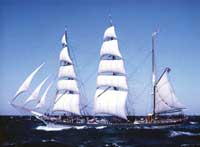 The barque Elissa is one of the true ship restoration success stories. The ship was rescued from near oblivion and restored at considerable cost by a dedicated group of volunteers. She has been well maintained in Galveston and has been taken on yearly sails, a remarkable achievement in its own right for a ship built in 1877. Nevertheless, earlier this month, the US Coast Guard determined that due to corrosion in the hull plates, the ship was no longer seaworthy. What happened?
The barque Elissa is one of the true ship restoration success stories. The ship was rescued from near oblivion and restored at considerable cost by a dedicated group of volunteers. She has been well maintained in Galveston and has been taken on yearly sails, a remarkable achievement in its own right for a ship built in 1877. Nevertheless, earlier this month, the US Coast Guard determined that due to corrosion in the hull plates, the ship was no longer seaworthy. What happened?
First, what didn’t happen. Unlike a number of historic ships in the United States and around the world, the Elissa was not neglected. Volunteers donate 30,000 hours per year on her upkeep and she is watched over by an experienced team of ship preservationists. Her hull was sound when she was dry docked in 2008. How could her hull have corroded so quickly in the course of the normal drydocking cycle?
The answer appears to be that the Elissa was a victim of stray AC current electrolytic corrosion, an all too common problem in many yacht marinas, yet one that is often not well understood.
All metal underwater corrodes through electrolysis. Steel, copper and zinc in salt water all act like the copper and lead plates in a car battery with the salt water itself acting as the battery acid. Zinc “anodes” corrode faster than steel or copper so are often used on hulls or near propellers to protect them against the natural electrolysis that takes place when different metals are placed near other in salt water. Sacrificial anodes are usually enough to protect a hull or hull fittings.
This changes dramatically if somehow a strong electric current is put into the water near a boat or ship with a metal hull or even metal hull fittings. How does electricity get into the water? Glance at most marinas and you will see a web of yellow electrical cables everywhere. What you don’t see are all the cabling running underneath the floating docks, which are prone to chafing and possibly leaking current into the water. In so called “hot marinas,” fiberglass boats have been known to suddenly sink because AC current leaking into the water has rapidly corroded the hull fittings. Even if the marina is not “hot,” a boater’s power cable being kicked into the water can have the same effect.
For a detailed discussion of the problem see, Stray Current Electrolytic Corrosion: An Unrecognized Enemy by Captain Alan Hugenot
In September 2008 we posted: Tall Ship Elissa – 1877 survives Hurricane Ike with little damage. That determination may have been highly premature. It now appears likely that during the hurricane in 2008, damage done to the docks probably also damaged electrical cabling, sending AC current into the water around the dock. This current leak near the Elissa’s hull, in all likelihood, caused the severe pitting and corrosion in sixteen of the ship’s hull plates.
The only good news from all this is that the Elissa is supported by the Galveston Historical Foundation, which has done such a good job in restoring the ship and is now raising funds to repair the damage to the hull related to stray current following Hurricane Ike.
To donate to the repair effort visit the the Galveston Historical Foundation or text ELISSA to 50555 on your cell phone to make a $10 donation.

Rick, shouldn’t it be zinc instead of lead, in terms of the type of anode?
Thanks Susan. Of course it should. I was thinking of lead acid car batteries and wrote the sentences badly. I fixed it. Thanks again.
I hope that GHF will contact the Pepsi Challenge to help secure funding for these major repairs as this ship is so well loved and will need several million dollars to return to sea.
Very interesting article … she had a long and colorful history – everyone wants to preserve her but you can’t keep slapping hull plates to cover rusty spots and think the problem will go away. Hell… how did she lasted so long?? 1950’s and 60’s yachts have the same problems?
Rick, as the spouse of one of the hard working Elissa volunteers, I thank you for this easy to understand explanation of the cause of the damage Elissa suffered–much better than my feeble attempts to fam & friends. I’m happy to post this on Facebook.
Pingback: Tall Ship Elissa Fundraising On Track – Not So Endangered After All | Old Salt Blog – a virtual port of call for all those who love the sea